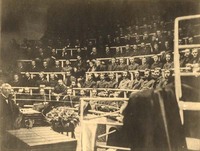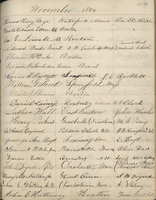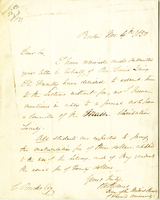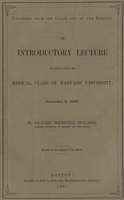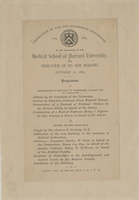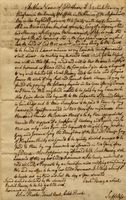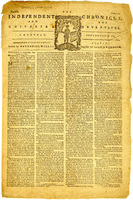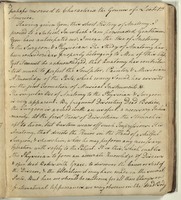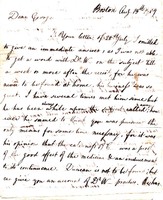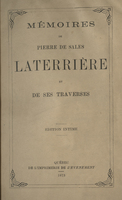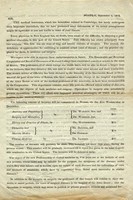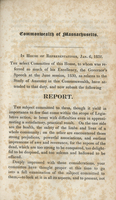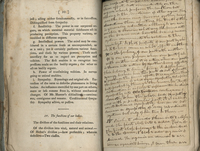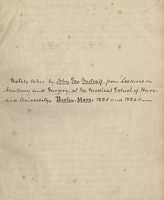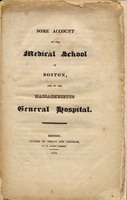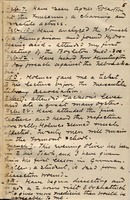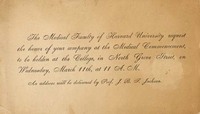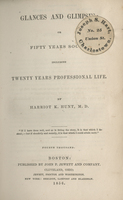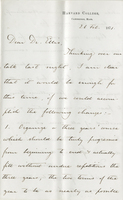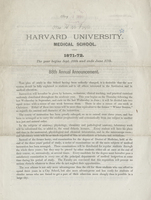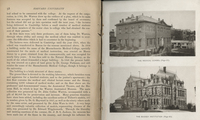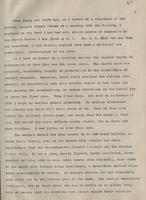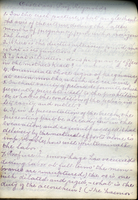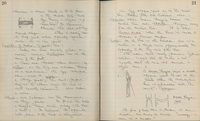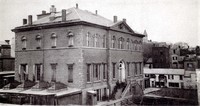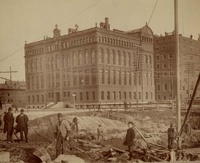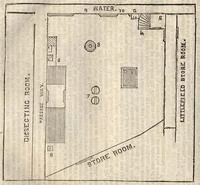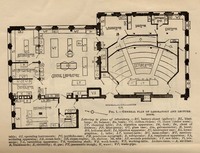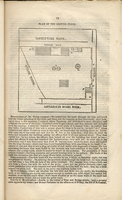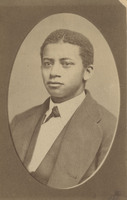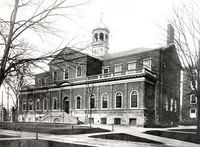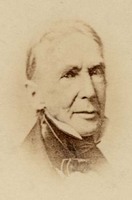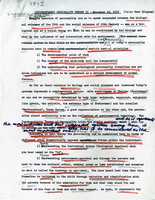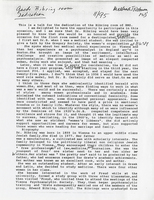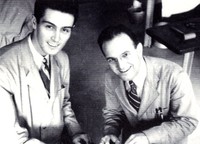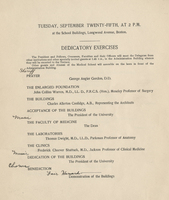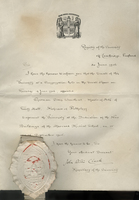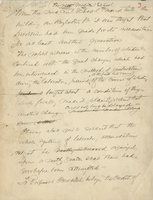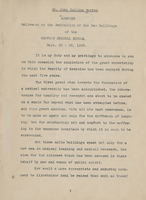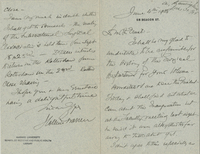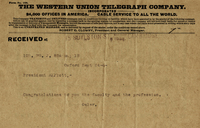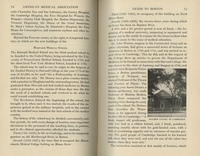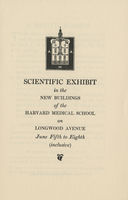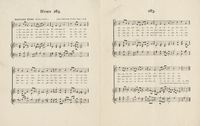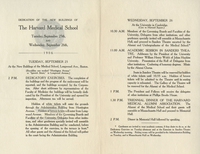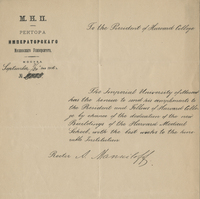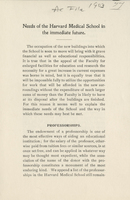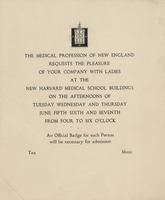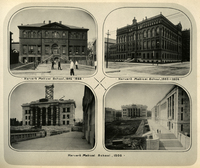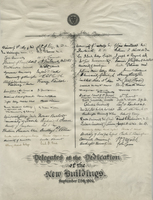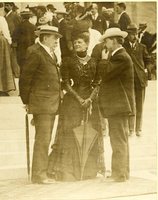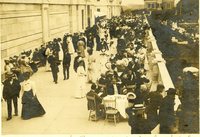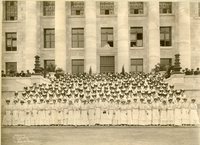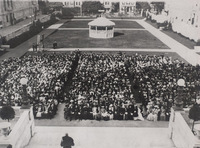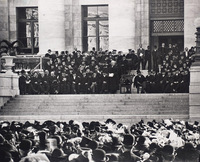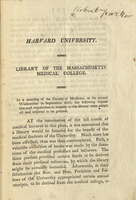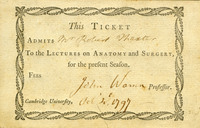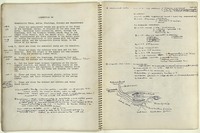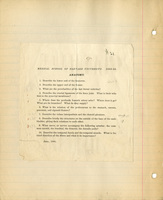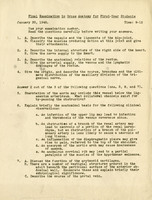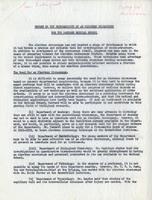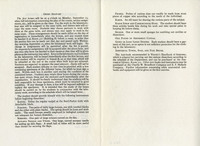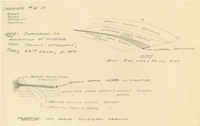Browse Items (140 total)
- Tags: Harvard Medical School
Sort by:
The Facts of Medicine program number 36, Overweight (video, program transcript, and film still)
David Davis Rutstein (1909-1986), S.B., 1930, Harvard College, M.D.; 1934, Harvard Medical School, Boston, joined the faculty at Harvard Medical School in 1947 as Professor of Preventive Medicine and was head of the Department of Preventive Medicine…
Farewell Address of Dr. Oliver Wendell Holmes
This photograph was taken on the occasion of Holmes’ retirement from teaching anatomy at Harvard and just after the opening of the school's new facility on Boylston Street. Some years later, Thomas Dwight recalled, “The scene was most…
Harvard Medical School in 1883
During the 1880s, Holmes was involved with the fund-raising appeals for the Medical School’s Boylston Street building. As part of the centennial celebration and dedication of the new building in 1883, he delivered this oration, tracing the…
Matriculating book
During the 19th century, every incoming medical student signed this volume at the beginning of the academic session and so agreed to follow the statutes of Harvard University and the direction of the Faculty of Medicine. On the page on the right can…
Letter from the Massachusetts Colonization Society to the Medical Faculty of Harvard College
This letter from Holmes’ tenure as dean of Harvard Medical School relates to the education of two African-American students, Daniel Laing, Jr., and Isaac H. Snowden. The Massachusetts Colonization Society promoted the education of Laing and…
Letter from Oliver Wendell Holmes to Charles Brooks
This letter from Holmes’ tenure as dean of Harvard Medical School relates to the education of two African-American students, Daniel Laing, Jr., and Isaac H. Snowden. Here, at Brooks’ appeal, Holmes waives the lecture fees for Laing…
Teaching from the chair and at the bedside
At the opening of the term and the beginnings of debate over educational reform at the Medical School, Holmes gave this address to the students, partly in defense of the summer term of practical instruction over the formal lectures of the winter.…
Program from Harvard Medical School centennial celebration
During the 1880s, Holmes was involved with the fund-raising appeals for the Medical School’s Boylston Street building. As part of the centennial celebration and dedication of the new building in 1883, he delivered this oration, tracing the history…
A Discourse upon the Institution of Medical Schools in America
The first book to be published on medical education in America was written by Dr. John Morgan, who founded the Medical Department of the University of Pennsylvania, the nation’s first medical school, in 1765. This particular copy is notable for…
Will of Ezekiel Hersey
In his will, Hingham physician Ezekiel Hersey bequeathed £1,000 to the Harvard Corporation to fund a professorship in anatomy and physic [physiology]. Although it took some years for the Corporation to establish a program of medical study, in…
The Independent Chronicle and the Universal Advertiser
This local newspaper was one of the first to report the formation of the Harvard Medical School following the plan devised by Dr. John Warren for the Harvard Corporation. The article announces the appointment of the first three faculty members and…
Lectures upon Anatomy
Partially in the handwriting of Dr. John Warren, this volume of lecture notes, beginning on December 10, 1783, contains the earliest surviving record of teaching at Harvard Medical School. The lectures were delivered in Harvard Hall, on the campus in…
Letter to George H. Hall
In 1788, John Fleet and George Holmes Hall became the first two graduates to receive medical degrees from Harvard. Here, in the following year, the two are in correspondence concerning treatment of several of their patients.
Mémoires de la P. de Sales Laterrière et de Ses Traverses
Pierre Laterrière, who first studied medicine under M. de la Rochambeau in France, came to Harvard and received the degree of Bachelor of Medicine in 1789. He went on to practice medicine in Canada. Laterrière’s Mémoires,…
Annual Circular
This first circular from the new location advertises the opportunity for students to examine patients at the Boston Almshouse on Leverett Street and announces the new professorship in clinical medicine.
The faculty was also concerned about the cost…
Report of the Select Committee of the House of Representatives ... Legalizing the Study of Anatomy
This state report provided key arguments for the repeal of the 1815 Act to Protect the Sepulchres of the Dead by the Massachusetts Legislature and so legalized dissection of human bodies for anatomical study. Dr. John Collins Warren, stressing the…
A Syllabus of the Lectures Delivered at the Massachusetts Medical College to the Medical Students of Harvard University
Harvard’s first professor of clinical medicine, James Jackson, found that the time spent with his students on the wards at Massachusetts General Hospital detracted from his formal lecturing, and so he published these brief notes of his lectures…
Medical Lectures
Dr. John George Metcalf of Mendon attended Harvard Medical School and used this notebook during the lectures of Drs. John Collins Warren, Jacob Bigelow, and Walter Channing. The notebook also served as Metcalf’s diary, and his account of life at…
Some Account of the Medical School in Boston, and of the Massachusetts General Hospital
This brief promotional pamphlet describes the Harvard Medical School at its Mason Street location and also the clinical and surgical opportunities offered by the new Massachusetts General Hospital. The school and hospital both at this period would…
First and Second Year in Medical School
Harvard professor James C. White was also a graduate of the Medical School. In 1898, at a meeting of the Vienna Club, he read these extracts from a diary he kept while at Harvard from 1853 until 1855. His entry for October 8, 1853, notes, “Many…
Notes on Lectures at Harvard Medical School
Although he never practiced as a physician, William James—philosopher and psychologist best known for The Varieties of Religious Experience(1902)—received a degree from Harvard Medical School in 1869 and taught physiology during the…
Medical Education : New Professorships in the Medical Department of Harvard University
The challenge to reform American medical education and bring it closer to the higher standards current in Europe started even before this editorial appeared in the Boston Medical and Surgical Journal. James C. White, a member of the faculty of the…
An Introductory Lecture Delivered before the Medical Class of Harvard University
Introductory lectures to new medical students were customary at the opening of each academic year and often printed in pamphlet form or, as here, in the pages of a medical journal. James C. White cautions the students against specializing too early…
Letter from Charles Eliot to Calvin Ellis
In this letter to Calvin Ellis, the dean of Harvard Medical School, President Eliot outlines several key factors in his proposed educational reforms: a three-year course sequence; examinations, partly written, in each department; familiarity with…
88th Annual Announcement
This broadside issued following President Charles W. Eliot's educational reforms outlines the revolution in Harvard's medical curriculum. The academic year now begins earlier, three years' study is required, and the importance of practical and…
Course Schedule
As part of the reform movement at Harvard, the recommended medical degree course was extended from three years to four in 1880. Students could still finish the requirements for an M.D. in three years, and anyone who completed a fourth was granted the…
Harvard and Its Surroundings
This 19th century guidebook to Harvard University describes the current—and overcrowded—conditions of the Medical School on North Grove Street as well as some of the collections of the Warren Anatomical Museum. A building on Cambridge Street was…
Reminiscences
At the time of his death, Dr. Alfred Worcester—a member of the Harvard College Class of 1878—was the University’s oldest living graduate. He was also an 1883 graduate of the Medical School. In the 1940s, Dr. Worcester composed his…
Examination Papers in Medicine : First, Second and Third Year
Following reform, rigorous medical examinations at the end of each year became a requirement for Harvard students. These are the exam questions posed by Dr. John P. Reynolds to third-year students in obstetrics during the 1877-1878 academic…
Student Lecture Notes on Anatomy
Even the most renowned of neurosurgeons was once a first-year medical student, as illustrated by this volume of Harvey Cushing's notes on the anatomical lectures of Thomas Dwight. The Harvard Medical School student at this period attended anatomy…
Mason Street Building
The Harvard Corporation, at the instigation of the Medical Faculty, petitioned the Massachusetts state legislature for funds to build an adequate home for the Medical School. The Faculty received a grant of $18,000 to obtain land and erect the first…
The North Grove Street Building
In 1847, Harvard Medical School erected a new building, on North Grove Street, adjoining Massachusetts General Hospital, on land donated by Dr. George Parkman—whose body would all too soon be found buried beneath it. The school building itself…
The Parkman Murder : Trial of Prof. John W. Webster for the Murder of Dr. George Parkman
While few early photographs exist of the Harvard Medical School building on North Grove Street, considerable information about the structure and its interior can be found, ironically, in the published transcripts of the 1850 murder trial of John W.…
Description of the Physiological Laboratory
A large proportion of the new building on Boylston Street was devoted to laboratory space with adequate natural light. The Physiological Laboratory (“… intended to serve primarily as a laboratory of research, and secondarily as an…
Trial of Professor John W. Webster for the Murder of Doctor George Parkman
While few early photographs exist of the Harvard Medical School building on North Grove Street, considerable information about the structure and its interior can be found, ironically, in the published transcripts of the 1850 murder trial of John W.…
Robert Tanner Freeman
Part of a set of photographs of members of the first graduates of the Harvard Dental School, this image of Robert Tanner Freeman (d. 1873) is particularly interesting. Dr. Freeman was born in Washington, D.C., and was the son of former slaves from…
George Franklin Grant
Dr. George Franklin Grant (1847-1910) of Oswego, New York, received a degree from the Harvard Dental School in 1870 and then joined the faculty as an authority on mechanical dentistry. He was the first African-American faculty member at the…
Holden Chapel
Students attended lectures in the basement of Harvard Hall, but by 1797, the condition of this facility was described—at least for Aaron Dexter's lectures on chemistry—as "unhealthy, inconvenient, and disgraceful," and new space was then provided in…
Admission Ticket to a lecture at Harvard Medical School
The use of admission tickets for each course of a medical student’s education was common until the late 19th century. Students paid the lecturer or professor directly and were then issued these passes for an academic session. This particular…
John Collins Warren
One of the most renowned American surgeons of the 19th century, Dr. John Collins Warren (born on August 1, 1778) graduated from Harvard College in 1797, then began the study of medicine with his father, Dr. John Warren. In 1799, he went abroad,…
Dr. John Warren
In 1780, during the Revolutionary War, surgeon John Warren (1753-1815) began to deliver anatomical lectures to physicians at the military hospital in Boston. Warren went on to deliver public lectures during the winter of 1781-1782, at the invitation…
Gordon Hall Room Dedication
In the early 1990
Joseph Murray as Harvard Medical School Student
Joseph Murray and unidentifed man as students at Harvard Medical School
Laudate Dominum
Harvard's Assistant Professor of Music, F. S. Converse, composed this choral work for the dedication of the new Medical School buildings on September 26th. A chorus of alumni under the direction of Harvard's choir-master performed the piece. A…
Dedication of the New Buildings of the Harvard Medical School
This is a program from the two-day exercises at the dedication, September 25th and 26th, 1906. The faculty speeches and the formal dedication of the Longwood campus were followed the next day by an academic session on the Cambridge campus, with a…
Invitation to the Dedication Ceremonies
This invitation was sent to Dr. Joseph Grindon, the Professor of Clinical Dermatology at Washington University, in St. Louis.
Appointment Certificate of German Sims Woodhead
Honored guests from medical schools in the United States and Europe were present at the dedication ceremonies. This certificate from the Registrary attests to the appointment of Sir G. Sims Woodhead (1855-1921), Professor of Pathology, as the…
Letter from J. Pierpont Morgan to J. Collins Warren
Financier and industrialist J. Pierpont Morgan was the most significant benefactor to the construction of the Quad buildings. His magnificent gift of $1,135,000—the single largest donation received by Harvard to that point—underwrote the…
The Enlarged Foundation
Just as his great-grandfather had been instrumental in establishing the Harvard Medical School in the eighteenth century, so Dr. J. Collins Warren provided the impetus for the construction of the buildings of the Quad at the beginning of the…
Letter from J. Collins Warren to Harold C. Ernst
Although there was doubt on the part of President Eliot that the Longwood buildings would be ready for the meeting of the American Medical Association in June 1906, as this letter of J. Collins Warren attests, the architects affirmed that, within a…
Telegram to Charles W. Eliot from Sir William Osler
Although invited to the dedication, physician Sir William Osler—who had just been named Oxford's Regius Professor of Medicine—could not attend, but did telegraph his congratulations.
Dedication of the New Buildings of the Harvard Medical School
This extended version of the dedication program contains transcripts of the speeches and address of Dr. William H. Welch. The dean of the Medical School, William L. Richardson, said, "In these new buildings all that one could ask for has been…
A Guide-Book of Boston for Physicians
The 1906 annual meeting of the American Medical Association was held in early June and provided an occasion for the first public opening of the Quad buildings. Dr. Walter L. Burrage, of the Sub-Committee on Printing and Programmes, edited this guide…
Scientific Exhibit in the New Buildings of the Harvard Medical School
During the course of the AMA meeting, demonstrations, lectures, models, photographs and slides, and other anatomical, pathological and scientific exhibits were all mounted in the amphitheaters, laboratories, and museum galleries of the new buildings.…
Hymn 283
The so-called "Harvard Hymn" was sung by the Alumni Chorus at the Academic Session of the Dedication on September 26th. It was composed by John Knowles Paine, the University's late professor of music.
Names for Honorary Degrees
As part of the dedication ceremonies, honorary degrees were to be presented to some distinguished physicians. In this memo, the dean of the Medical School, William L. Richardson, canvasses and records the opinions of some of the faculty members on…
Letter of congratulations from Moscow
The Medical School received formal letters of congratulation on the opening of the new buildings from other medical schools in the United States and from institutions abroad, including this unusual greeting from the rector of the Imperial University…
Needs of the Harvard Medical School in the Immediate Future
As a complement to the fund raising campaign for the new campus, Drs. H. P. Bowditch and J. Collins Warren produced this pamphlet to inspire donations to endow professorships, departments, and scholarships at the school.
Invitation to Tea
Each afternoon during the American Medical Association's meeting in Boston, a musical tea was held on the new Medical School Quadrangle.
The Medical School of Harvard University, Class of 1906
The Aesculapiad, the yearbook for Harvard Medical School, first appeared in 1924, but it had this unique precursor in 1906, in conjunction with the opening of the new buildings. The yearbook contains photographs of the faculty and the 68 graduating…
The Harvard Medical School, 1782-1906
Although Thomas Francis Harrington published a three-volume history of the Medical School in 1905, the dedication of the new buildings prompted the appearance of this shorter commemorative work, with a history of the individual departments and a…
Drs. J. Collins Warren and Arthur M. Rounds
Dr. Warren [left] was chairman of the Entertainment Committee for the AMA meeting. The woman at his side may be Mrs. Roger Wolcott who organized the afternoon teas at the Medical School.
Pres. Eliot speaking at Longwood Avenue Quadrangle dedication, detail of university officers and guests
Persons depicted: President Eliot (standing), to his right: Gov. Curtis Guild, Jr., Baron Rosen, the Russian Ambassador, J.P. Morgan, and Charles H. Tweed, representing Mrs. Collis
Library of the Massachusetts Medical College
Harvard Medical School established a library of its own in 1816. This pamphlet of rules was printed and distributed to students following the collection's unification with the Boston Medical Library in 1819.
A hebdomadal reminiscence of diurnal events
James Arthur Emmerton (HMS 1858) of Salem used this diary every Sunday to record his experiences a student at Harvard Medical School from 1855 through 1857. He then returned to it to document life in the 23rd Massachusetts Volunteers during the…
Admission ticket to the lectures on anatomy and surgery
for Robert Thaxter
The use of admission tickets for each course of a medical student's education was common until the late 19th century. Students paid the professor or lecturer directly and were then issued these passes for an academic session. Robert Thaxter…
Laboratory guide for gross dissection
The Department of Anatomy produced and distributed this step-by-step manual for dissection "to help the student in the important task of displaying for study the structure of the human body. It represents one plan for completing each day's work with…
Report on the desirability of an electron microscope for the Harvard Medical School
Drs. Fawcett, for the Department of Anatomy, and Sognnaes, in the School of Dental Medicine, along with Professor Solomon in the Biophysical Laboratory outlined the need for an electron microscope at HMS, a report probably addressed to the dean.…
Course outlines for anatomical lectures and dissections
This notebook was used by John Warren as Assistant, later Associate, Professor of Anatomy, to record the daily outline of lectures and dissections for first and second-year students, from 1911 to 1916. The pages displayed record Warren's notes on…
Student laboratory dissection exercises
First-year medical students, DeWitt Allen Green, Ernest Bingham Oliver, Harold Bengloff, and Bruce Robinson Merrill, produced these drawings as part of their assigned course work on a cadaver in the fall of 1934.
According to the description in…
The Aesculapiad
These photographs show members of the Class of 1971 in anatomy lectures and the dissecting room.


